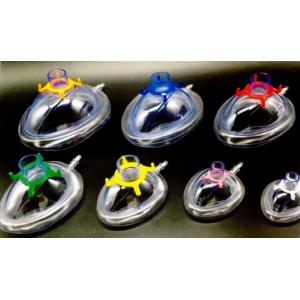

Add to Cart
Description:
HENAN AILE INDUSTRIAL CO., LTD is a professional manufacture of Anesthesia and Respiratory medical consumables with more than 10 years. And our factory is ISO certified Group which commit itself to R&D of medical consumables, all products have been CE approved .
In detail, Anaesthesia Face mask is an indispensable tool for general anesthesia.The mask can cover the mouth and nose of the patient and is connected to the anesthesia machine through the anesthesia pipeline to provide the patient with an effective non-invasive breathing circuit.
Anaesthesia face masks are rubber or silicone masks that cover both the mouth and nose of the patient.Typically, face masks are made from a clear plastic or rubber that allows the patient's mouth and nose to be seen so that foreign material (e.g., vomitus, blood) and condensation may be observed.
An anesthesia face mask, also known as a anesthesia mask or a surgical mask, is a medical device used in anesthesia to deliver anesthetic gases to a patient's airways during surgery or other medical procedures. It is a mask that covers the nose and mouth of the patient and is designed to create a seal over the patient's face, ensuring that the anesthetic gases are delivered effectively.
Here are some key features and components of an anesthesia face mask:
During anesthesia induction, the anesthesia provider places the mask over the patient's face, ensuring a proper fit and seal.
Anesthetic gases, such as sevoflurane or isoflurane, along with oxygen, are delivered through the mask and inhaled by the patient. The gases help induce and maintain anesthesia, keeping the patient unconscious and pain-free during the procedure.
It's important to note that the use of anesthesia masks requires proper training and expertise, and they should only be used by qualified healthcare professionals.
When choosing an anesthesia face mask, several factors should be considered to ensure a proper fit and effective delivery of anesthesia gases. Here are some key considerations:
Size: Anesthesia masks come in different sizes to accommodate patients of various ages and anatomical differences. It is important to select the appropriate mask size that fits the patient's face properly. Using an improperly sized mask can result in leaks and compromise the delivery of anesthetic gases. The mask should cover the nose, mouth, and chin adequately without excessive pressure or gaps.
Material: Anesthesia masks are typically made of silicone or rubber. Both materials are flexible and provide a good seal. Silicone masks are often preferred as they are less likely to cause allergies or skin irritation.
Inflatable Cuff: Some anesthesia masks have an inflatable cuff around the edges. The cuff can be inflated to create a tight seal around the patient's face, minimizing gas leakage. Ensure that the cuff is made of a durable and reliable material that can maintain inflation throughout the procedure.
Connector Compatibility: Check the connector type on the anesthesia mask to ensure compatibility with your anesthesia machine or breathing circuit. The connector should match the standard size and type used in your clinical setting.
Patient Population: Consider the patient population you frequently treat. If you work with pediatric patients, look for masks specifically designed for infants and children. These masks are smaller and have features that cater to their anatomical needs.
Visibility and Access: Opt for a mask that provides good visibility of the patient's face, allowing for proper monitoring and observation during the procedure. Additionally, consider masks with features that allow easy access to the patient's mouth or oral cavity for suctioning or other interventions.
Quality and Sterility: Ensure that the anesthesia mask is of high quality, compliant with relevant standards, and produced by a reputable manufacturer. Sterility is crucial to prevent infections, so verify that the masks are individually packaged and sterile.
It is advisable to consult with your anesthesia team or medical supplier who can assist in selecting the most suitable anesthesia face mask based on your specific needs and patient population.
How does mask anesthesia work?
Before your surgery, you'll get anesthesia through an IV line that goes into a vein in your arm or hand. You might also breathe in gas through a mask. You should fall asleep within a couple of minutes. Once you're asleep, the doctor might put a tube through your mouth into your windpipe.
Two of Air Cushion Anaesthesia Mask 'S functions used in clinical practice :
Use a face mask for anesthesia administration. When the patient needs to be inhaled for general anesthesia, the face mask will be used to cover the patient’s mouth and nose, allowing high-concentration oxygen and anesthetics to enter the body through the patient’s breathing, so as to achieve anesthesia. The purpose of the medicine.
Used for oxygen supply. For example, before performing intravenous general anesthesia intubation, the mask will be used to cover the patient’s nose and mouth, allowing the patient to inhale high-flow pure oxygen, that is, pre-oxygenation, to increase the oxygen in the patient’s lung The content provides sufficient time for the implementation of general anesthesia intubation.
